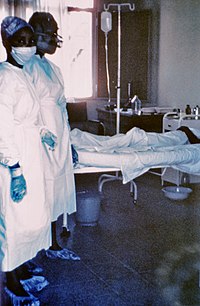
Photo from wikipedia
Infectious disease outbreaks in plants threaten ecosystems, agricultural crops and food trade. Currently, several fungal diseases are affecting forests worldwide, posing a major risk to tree species, habitats and consequently… Click to show full abstract
Infectious disease outbreaks in plants threaten ecosystems, agricultural crops and food trade. Currently, several fungal diseases are affecting forests worldwide, posing a major risk to tree species, habitats and consequently ecosystem decay. Prediction and control of disease spread are difficult, mainly due to the complexity of the interaction between individual components involved. In this work, we introduce a lattice-based epidemic model coupled with a stochastic process that mimics, in a very simplified way, the interaction between the hosts and pathogen. We studied the disease spread by measuring the propagation velocity of the pathogen on the susceptible hosts. Our quantitative results indicate the occurrence of a critical transition between two stable phases: local confinement and an extended epiphytotic outbreak that depends on the density of the susceptible individuals. Quantitative predictions of epiphytotics are performed using the framework early-warning indicators for impending regime shifts, widely applied on dynamical systems. These signals forecast successfully the outcome of the critical shift between the two stable phases before the system enters the epiphytotic regime. Our study demonstrates that early-warning indicators could be useful for the prediction of forest disease epidemics through mathematical and computational models suited to more specific pathogen–host-environmental interactions. Our results may also be useful to identify a suitable planting density to slow down disease spread and in the future, design highly resilient forests.
Journal Title: Ecological Modelling
Year Published: 2019
Link to full text (if available)
Share on Social Media: Sign Up to like & get
recommendations!